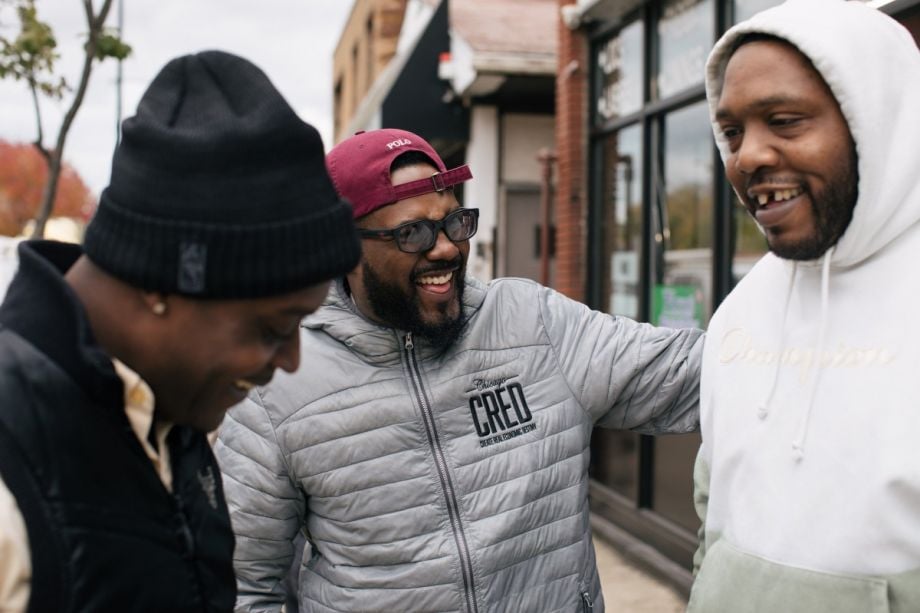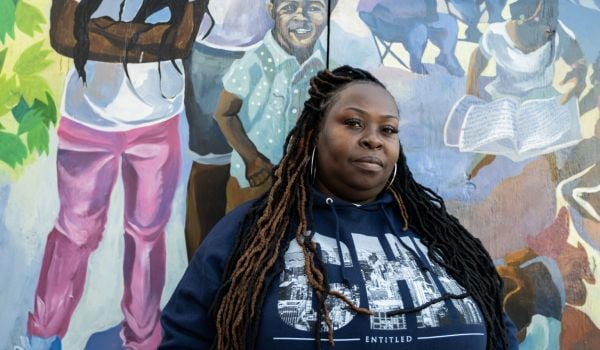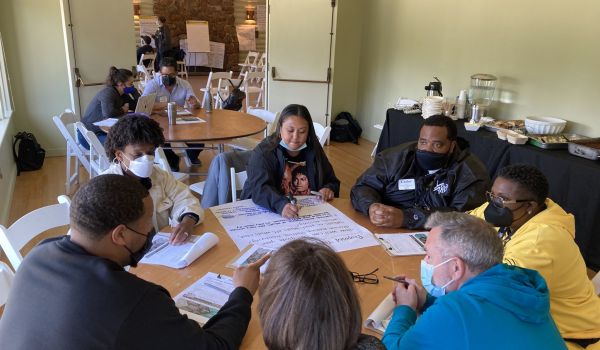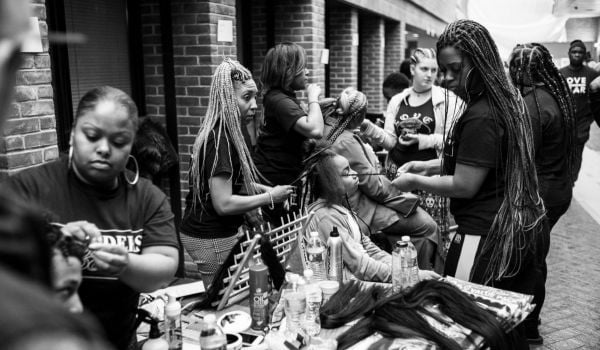Two years ago, Chicago outreach worker Donnell Gardner found himself texting a man holed up in a home in the Roseland neighborhood on the Far South Side. He had allegedly had a violent altercation with his girlfriend just prior; police suspected they were now dealing with a hostage situation. Gardner — who knew the couple and informally counseled the young man — texted him for several hours until he found a way to get through: “I’m trying to watch the game tonight, you know I love LeBron James,” Gardner recalls texting. “Due to the relationship I had with him, he agreed to come on out.”
“Since the police took it as a hostage standoff, I had him come out with his hands up and they didn’t kill him,” Gardner says. Police searched the home — there wasn’t a hostage, like they prepared for. Gardner believes if he hadn’t been there, the police would have killed him.
Gardner is a street outreach worker for Chicago CRED, a role also known as “violence interrupter” or violence intervention worker in cities around the country. The demands of this job are unique and inadequately studied, though that’s starting to change.
Gardner recently shared his insight for an ambitious survey of nearly all the street outreach workforce in Chicago. The first-of-its-kind survey, designed to better understand a profession often presented as an alternative to the police, resulted in its first working paper this May detailing violence intervention workers’ exposure to gun violence and highlighting the urgent need for trauma support.
“Our hope is that this is a small, humble step in providing some of the first systematic, city-level data on this workforce,” says David Hureau, an assistant professor of sociology at University of Albany who co-led the Violence Intervention Worker Study.
Street outreach work has its roots in early American cities, dating back to the early 1900s. Chicago has a particularly robust history, with Cure Violence starting there in the 1990s as a public health response to shootings. A model developed to recruit members of local communities — particularly people impacted by gangs and violence — to directly reach those most impacted by gun violence, mediate disputes, deescalate conflicts, and link to social services.
Violence intervention picked up mainstream attention in the 2000s, as part of an expansion of public health approaches to violence prevention. In Chicago, the latest big push came in 2016 after a spike in homicides. It’s grown even further alongside the Defund the Police movement, which has advocated for violence interrupters as one of many alternatives in communities with high police presence.
There’s conflicting views on the long-term impact of violence intervention, alongside a general consensus that this work has been underfunded, under-resourced and is difficult to study. Crucially, there’s been little investment in understanding the actual profession and its impact on the people who practice it.
“There’s this big question of ‘what is the work’ and also about professionalizing the work, which means training, pay, benefits, social respect, and a professional trajectory for staff,” explains Andrew Papachristos, a professor of sociology at Northwestern University who conducted the survey with Hureau.
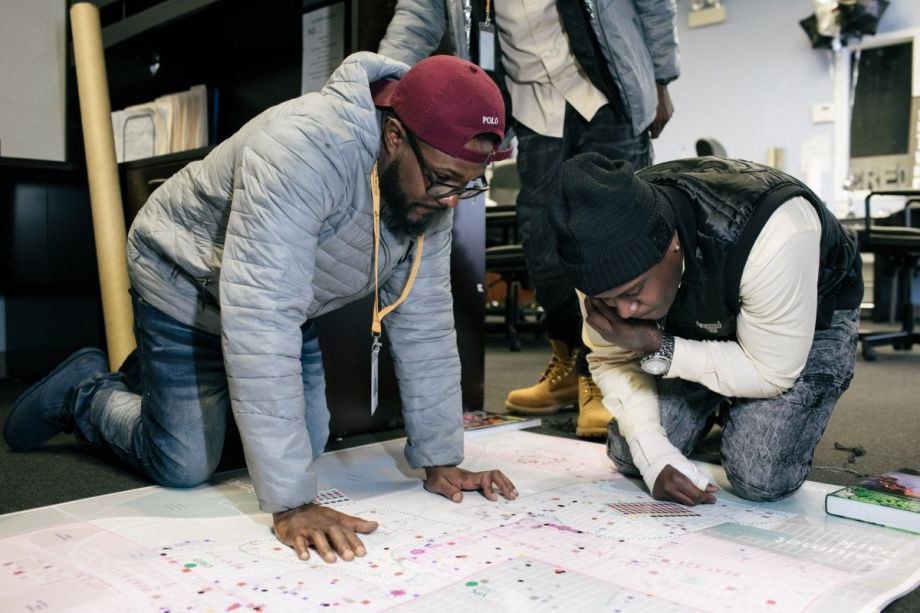
A team of outreach workers with the Chicago CRED program determine which neighborhoods to strategically target for violence prevention efforts based on the data. (Photo courtesy Chicago CRED)
Papachristos and Hureau — who both study violence intervention programs around the country — have wanted to survey this work for a decade. “We had built relationships in Chicago and had some support from Northwestern,” Papachristos says. “There aren’t many cities that have bigger operations in Chicago. This is the spot we’d get variation and see the work in different types of neighborhoods.”
They partnered with Chicago CRED and Institute for Nonviolence Chicago to begin trust-building and conversation with outreach workers across the city, most of whom are middle-aged Black men. “A lot of the [violence interrupter] groups had been burned in the past by universities and funding institutions so they were healthfully skeptical,” says Papachristos.
They consistently solicited feedback from outreach workers and workshopped questions, expanding the survey based on workers’ needs. ““In some cases we’d hear from outreach workers that they’d want to know about, say, retirement accounts, and we’d design questions around that,” Hureau said. They piloted the survey with a small group of outreach workers to further refine it.
The Violence Intervention Worker Study, or VIeWS, took place between March and November 2021, ultimately surveying 87% of the violence intervention workforce in Chicago. This May, the team released its first paper based on the findings. Focused on exposure to violence, it found that workers “regularly confront scenes of gun violence, injury, and death,” with nearly 12% reporting that they themselves had been shot at while working within the last year. More than 60% witnessed a shooting attempt while on the job; 32% witnessed a successful shooting.
The team released this paper first to convey an urgency around the work: There’s steep personal costs associated with violence intervention, with a need for improving worker safety, reducing worker exposure to violence, and developing robust support systems for the “most vulnerable practitioners on the front lines of community violence,” as the paper puts it.
The need for trauma-informed support is crucial, according to Kathryn Kelly Carroll, a licensed clinical social worker with the Institute for Nonviolence Chicago. While Institute for Nonviolence Chicago supported this latest survey, Carroll independently collaborated with University of Illinois Chicago professor Kathryn Bocanegra to release a separate, more qualitative report last year about trauma exposure and street intervention.
“Most of the models we have to address trauma in the clinical world are about past trauma, but the majority of folks doing this work are still living in communities where trauma is happening everyday, and they’re consistently exposed to it,” she says. “There isn’t a ton of research out there for treating ongoing trauma, and there’s almost none for this specific population.”
Papachristos and Hureau will continue to tie their survey findings to policy recommendations. Future papers will explore issues like inadequate pay and benefits, the desire of violence intervention workers for more upward career trajectories, and the high rates of turnover and attrition.
“We need to get paid better, across the board,” says outreach worker Gardner. “I speak for every outreach worker in Chicago when I say we need more money and more support.” He also stresses that violence intervention can only be successful when it’s tied to larger wraparound services for the community, like meaningful employment, educational opportunities and counseling.
Carroll, too, believes that surveys and studies are important first steps, but what’s needed are more systemic changes like consistent funding and holistic, trauma-informed investments for both violence intervention workers and the communities they work in. “Let VIeWS be a starting point and let’s dig in from there,” she says.
“We really understood this survey as a crucial piece of information not just for science, or the legitimacy of their field and their profession, but as a means for organizing,” says Hureau. “In Chicago there’s an understanding that there is still organizing work to be done, and that this organizing required reliable, systematic information that could change policy discourse.”

Emily Nonko is a social justice and solutions-oriented reporter based in Brooklyn, New York. She covers a range of topics for Next City, including arts and culture, housing, movement building and transit.
Follow Emily .(JavaScript must be enabled to view this email address)

